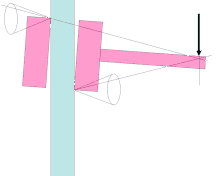Drawer effect
The drawer effect describes the mechanical jamming of a slide on a guideway as a result of tilting.
root cause
It is triggered by a torque acting on the slide .
If the guide length is less than twice the distance of the force introduced multiplied by the coefficient of static friction , there is a risk of self-locking :
and
Short guidance and high friction thus promote the effect.
In order to make sliding guides as smooth as possible, the greatest possible guide play should be aimed for. As a result, the outermost edges of the slide bearings first touch the guideway, which maximizes the guideway length. In addition, the guide becomes significantly more tolerant of form defects such as irregularity or load-related deflection.
In machine tools in particular , the drawer effect is avoided by arranging the guide axis and drive axis as close to one another as possible. So is z. B. with a lathe the prismatic guide is usually localized on the side of the slide spindle, with a milling machine the drive acts in the middle between a dovetail guide, etc. With these clever arrangements, the guides can be made very stiff and with little play despite the higher tendency to tilt.
Effects

The effects of the drawer effect, similar to those of the stick-slip effect , can be observed on the basis of a stuttering movement of a sled up to its complete blockage when an eccentric force is applied.
The name drawer effect is derived from the effect of a drawer jamming in the drawer slide, the cause and effect of which can largely be avoided using telescopic slide guides . The reason for this is the considerably lower coefficient of friction of rolling friction compared to surface sliding friction .
Footnotes
- ^ Klaus Jörg Conrad: Taschenbuch der Werkzeugmaschinen , Carl Hanser Verlag Munich Vienna, 2002, ISBN 3-446-21859-9







